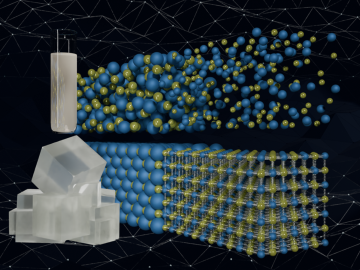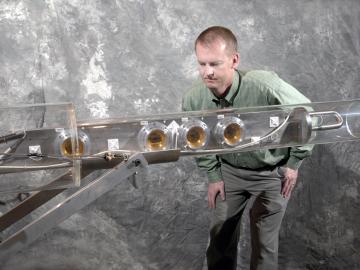
Filter News
Area of Research
- Advanced Manufacturing (5)
- Biological Systems (1)
- Biology and Environment (29)
- Computational Biology (2)
- Computational Engineering (2)
- Computer Science (5)
- Energy Science (36)
- Fusion and Fission (9)
- Fusion Energy (7)
- Isotopes (27)
- Materials (53)
- Materials for Computing (9)
- National Security (37)
- Neutron Science (119)
- Nuclear Science and Technology (19)
- Nuclear Systems Modeling, Simulation and Validation (1)
- Quantum information Science (2)
- Sensors and Controls (1)
- Supercomputing (47)
News Type
News Topics
- (-) Advanced Reactors (37)
- (-) Biomedical (70)
- (-) Cybersecurity (34)
- (-) Isotopes (58)
- (-) Machine Learning (64)
- (-) Neutron Science (163)
- (-) Security (29)
- 3-D Printing/Advanced Manufacturing (138)
- Artificial Intelligence (127)
- Big Data (70)
- Bioenergy (109)
- Biology (126)
- Biotechnology (38)
- Buildings (65)
- Chemical Sciences (83)
- Clean Water (32)
- Composites (33)
- Computer Science (216)
- Coronavirus (47)
- Critical Materials (28)
- Education (5)
- Element Discovery (1)
- Emergency (4)
- Energy Storage (107)
- Environment (202)
- Exascale Computing (65)
- Fossil Energy (8)
- Frontier (61)
- Fusion (63)
- Grid (70)
- High-Performance Computing (125)
- Hydropower (12)
- Irradiation (2)
- ITER (9)
- Materials (147)
- Materials Science (145)
- Mathematics (11)
- Mercury (12)
- Microelectronics (4)
- Microscopy (51)
- Molten Salt (10)
- Nanotechnology (58)
- National Security (81)
- Nuclear Energy (113)
- Partnerships (68)
- Physics (64)
- Polymers (31)
- Quantum Computing (52)
- Quantum Science (90)
- Simulation (61)
- Software (1)
- Space Exploration (26)
- Statistics (4)
- Summit (70)
- Transportation (92)
Media Contacts

Scientists have developed a new machine learning approach that accurately predicted critical and difficult-to-compute properties of molten salts, materials with diverse nuclear energy applications.

Van Graves, an engineering manager at ORNL, is celebrating 40 years of dedicated service leading a diverse range of prominent engineering projects at ORNL and internationally.

Using the Frontier supercomputer, a team of researchers from the Massachusetts Institute of Technology conducted large-scale calculations to chart the isospin density of a neutron star across a range of conditions. Their work provides new insights into how pressure and density interact within neutron stars, offering important predictions about their inner workings.

The Heartbeat Detector, developed at ORNL and licensed by Geovox Security Inc., detects hidden individuals in vehicles by measuring suspension vibrations. Now using a compact black box and cloud software, the system is more affordable and easier to use, while remaining the industry standard worldwide.

Jesse Labbé aims to leverage biology, computation and engineering to address societal challenges related to energy, national security and health, while enhancing U.S. competitiveness. Labbé emphasizes the importance of translating groundbreaking research into practical applications that have real-world impact.
Researchers at Oak Ridge National Laboratory have developed a modeling method that uses machine learning to accurately simulate electric grid behavior while protecting proprietary equipment details. The approach overcomes a key barrier to accurate grid modeling, helping utilities plan for future demand and prevent blackouts.

Scientists at the Department of Energy’s Oak Ridge National Laboratory recently welcomed Vanderbilt University colleagues for a symposium on basic science research, with a focus on potential collaborations in the biomedical and biotechnology spaces.
Daniel Jacobson, distinguished research scientist in the Biosciences Division at ORNL, has been elected a Fellow of the American Institute for Medical and Biological Engineering, or AIMBE, for his achievements in computational biology.
Dave Weston studies how microorganisms influence plant health and stress tolerance, using the Advanced Plant Phenotyping Laboratory to accelerate research on plant-microbe interactions and develop resilient crops for advanced fuels, chemicals and
Scientists at ORNL and the University of Cincinnati achieved a breakthrough in understanding the vulnerability of microbes to the butanol they produce during fermentation of plant biomass. The discovery could pave the way for more efficient production of domestic fuels, chemicals and materials.


